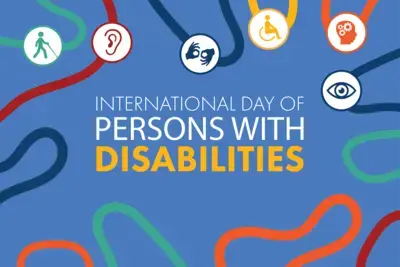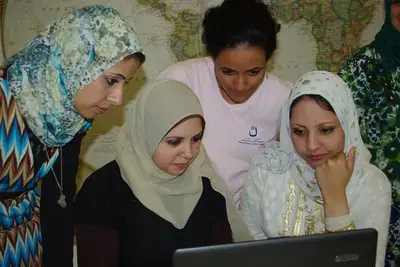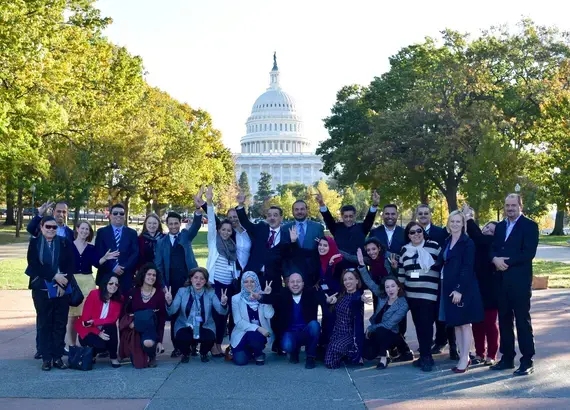
Delegates from eight Arab countries participate in NDI's Campaign Schools study mission looking at the U.S. elections campaign process.
Success Story
Seeing the U.S. Election through International Eyes
Elections in the United States are unique -- not only due to the decentralized election framework and history of campaigning, but also for the impact that presidential results in particular have around the world. This year Americans cast their votes for 469 members of Congress and 6,064 state-level elected leaders, in addition to dozens of ballot measures in individual states. Outshining many of these races of course, has been the presidential competition which included two historic candidates: the first woman representing a major party and a first-time office seeker who beat out 16 other primary candidates to secure a party’s nomination.
In light of these contrasts and with the support of the U.S. Department of State’s Middle East Partnership Initiative (MEPI), NDI hosted a delegation of 18 political activists from eight Arab countries who have graduated from the Institute’s Middle East and North Africa (MENA) Campaign Schools program to take a close look at the campaigning process and consider what aspects may translate to their parties and campaigns at home. Since the program’s inauguration in 2012, 387 graduates have passed through an intense curriculum focused on devising strong strategies for political parties and adapting tested tactics during campaigns. These activists come from more than 90 political parties in twelve countries and have gone on to train more than 17,000 other activists in their countries and across the region in campaigning and political skills. Thirty have run for office, and 42 have worked on electoral campaigns. Fifteen have won elected office. Many others have used skills learned through the program in campaigns for internal party, university and union elections. Still more have been promoted to leadership positions within their parties and are preparing for future campaigns.
The study mission delegation included campaign managers and former or potential candidates from Algeria, Bahrain, Iraq, Jordan, Lebanon, Morocco, Saudi Arabia and Tunisia. They began the mission in Washington, D.C., where they spent three days meeting with Democratic and Republican campaign strategists, political commentators, pollsters, leading journalists and academics. The meetings covered the American campaign process, infrastructure and execution, giving the participants a chance to learn from U.S. campaign experts and setting the stage for their deployments to observe campaign activities up close. Among the panelists were:
- Joyce Karam, Washington Bureau Chief, Al Hayat Newspaper
- Eugene Scott, Reporter, CNN Politics
- Ellen Weintraub, Commissioner, Federal Elections Commission
- Stuart Stevens, Top Strategist, Mitt Romney 2012 Presidential Campaign
- Mark Beatty, Post-Election Evaluation Lead, Obama 2008 / 2012 Presidential Campaigns
- Lynda Tran, Founding Partner, 270 Strategies
- Whit Ayres, President, North Star Opinion Research
- Michael Bocian, Founding Partner and Principal, GBA Strategies
- Aaron Leibowitz, Targeted Creative Communications
- John Hagner, Clarity and Campaign Labs
- Hector Sigala, Digital Media Director, Bernie Sanders Campaign 2016
- Rebecca Heisler, Former Social Media Director, Mitt Romney 2012 Presidential Campaign
- Erin Lindsay, Former Deputy Director for Online Engagement, White House
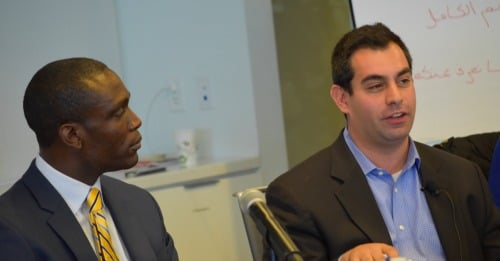
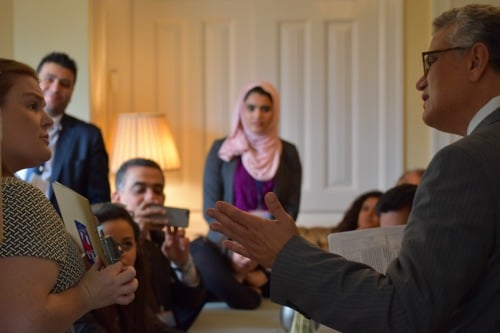
The delegates then fanned out in smaller teams to three states to witness the closing days of local campaigning efforts. Delegates went to Michigan, Pennsylvania and New York, where they met with candidates and their teams to discuss how they were implementing their campaigns and the challenges they were facing. The groups also learned how interest groups play a role in endorsing candidates and mobilizing volunteers, attended campaign rallies of both presidential nominees and observed Get-Out-The-Vote efforts in the run-up to November 8.


Back in Washington after election day, delegates reflected on key aspects of U.S. campaigns which resonated with them most. These three aspects stood out:
Appealing to Voters Based on Their Values
Through presentations by leading pollsters, delegates were exposed to the various methods of data collection related to voter attitudes on candidates and issues. Whit Ayres, head of a research firm servicing conservative candidates told the delegation, “Public opinion research, if correct and consistent, helps candidates get the basic message right.” Several delegates noted that given the cost of polling, conducting research can be a challenge during and beyond campaign periods. NDI staff and panelists noted that when resources are limited, political parties can design and conduct their own surveys. This not only helps take the pulse of voters, but provides and opportunity for party members to be involved in party operations. At the state level, delegates saw how campaign messages were adapted from national slogans and tailored by candidates based on concerns of their target voters. The issue of health care is an example: candidates in Syracuse focused on countering growing opioid addiction, while candidates in Detroit and Philadelphia crafted messages to address hospital overcrowding and general poverty.
Using Technology to Support Strategy
Delegates also saw how campaigns use data to build a picture of each voter, to fundraise and to communicate with voters. “Building collaboration between campaigns and data collection over election cycles will strengthen any individual candidate’s campaign,” noted Micah Morris of NGP VAN, the main data management system used by the Democratic Party and other progressive organizations.
While campaign strategists noted the importance of direct contact with the voter, presidential campaigns also demonstrated the power technology can play in delivering messages and receiving information from supporters. Both the Trump and Clinton campaigns relied on digital tools as a means to communicate directly with voters who increasingly rely on cell phones as their primary means of contact. Rebecca Heisler, Mitt Romney’s Social Media Director for the 2012 campaign noted, “people like to have access to candidates. Use social media to create that closeness.”
Inspiring and Managing Volunteers
A common challenge delegates noted from campaigns in their home countries was how to recruit and keep volunteers engaged in campaigns. American grassroots organizers for various campaigns consistently stressed the need to link the personal to the political for voters and volunteers alike. This link between their daily lives and taking action based on values they hold has consistently proven to motivate volunteers in U.S. campaigns. Delegates observed diverse opportunities for volunteers to get involved, including phone banking, canvassing, financial donations and directly contributing to the campaign message through campaign surveys.
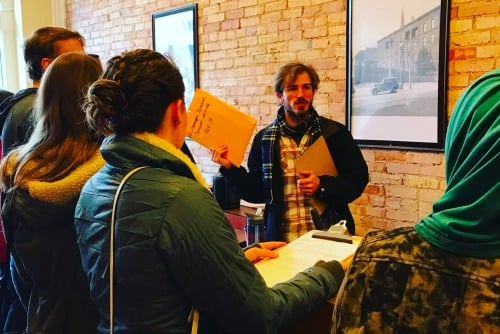
“I will immediately form a team of volunteers prior to the election period in charge of canvassing in order to collect information about voters including their address, phone numbers and political leanings, because my government does not provide this data to parties.” -- Lebanese delegate
Beyond the campaign process and results, delegates came away from the study mission with a deeper understanding of American political culture and the values around elections. With ongoing support from the U.S. Department of State, NDI will continue to aid political parties and activists throughout MENA in building inclusive election campaign strategies, with an aim for stronger governance that includes citizen voices.
“You can count on a peaceful transition of power in January, on other institutions of government playing their part and that elections will happen again in four years!” -- Moroccan delegate
